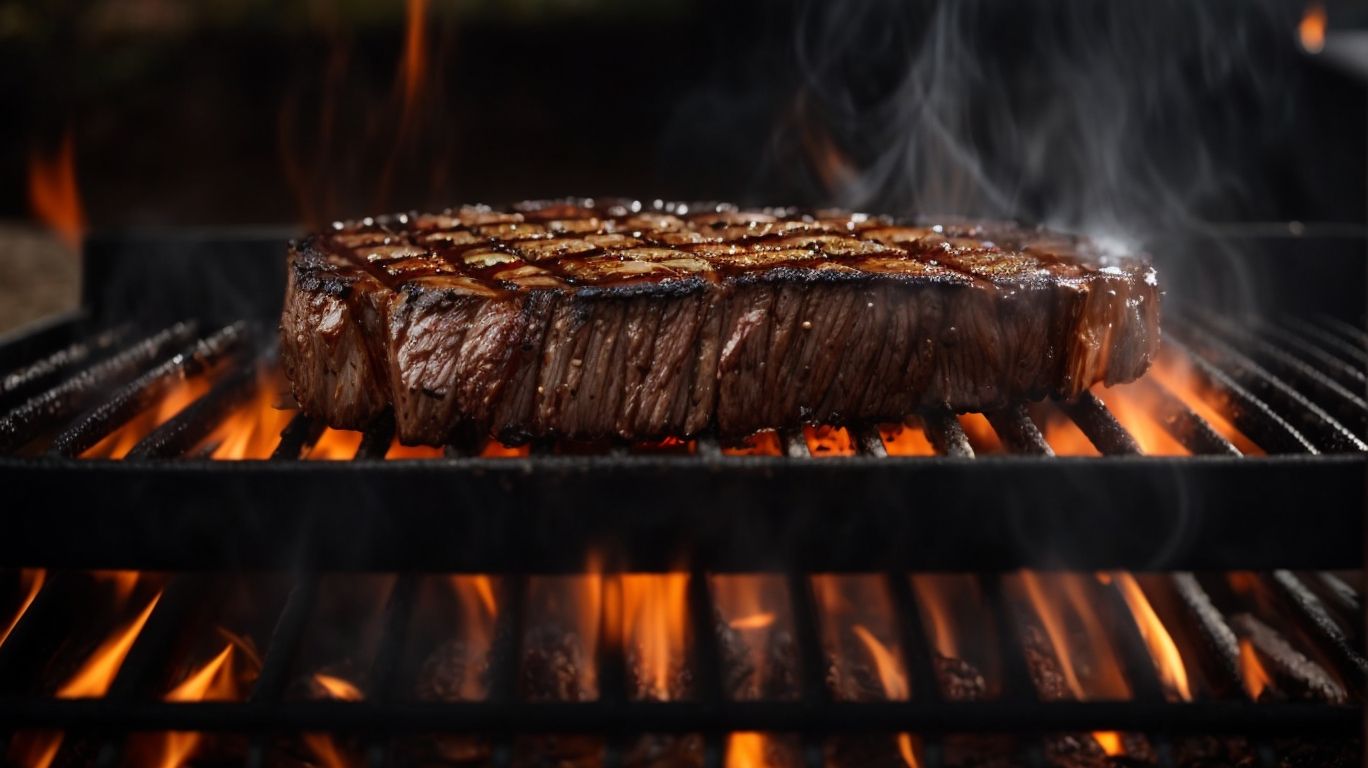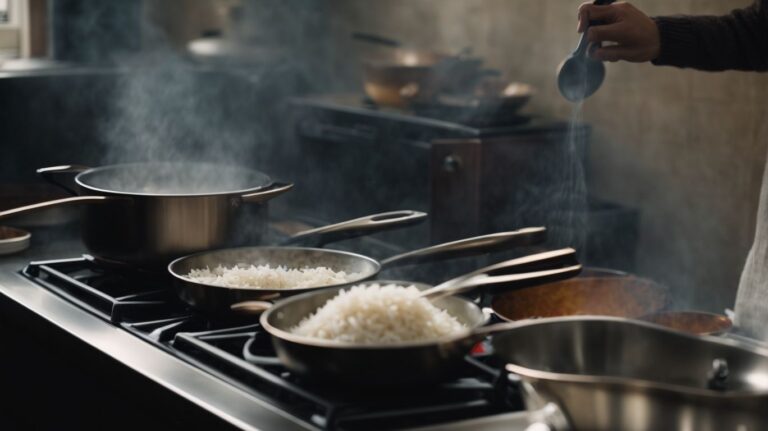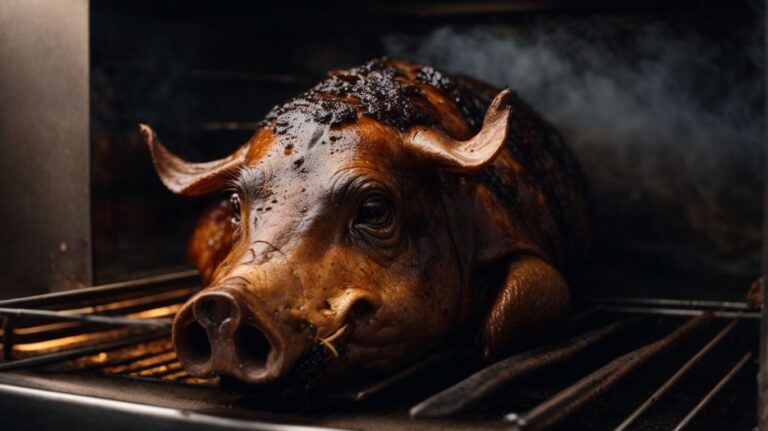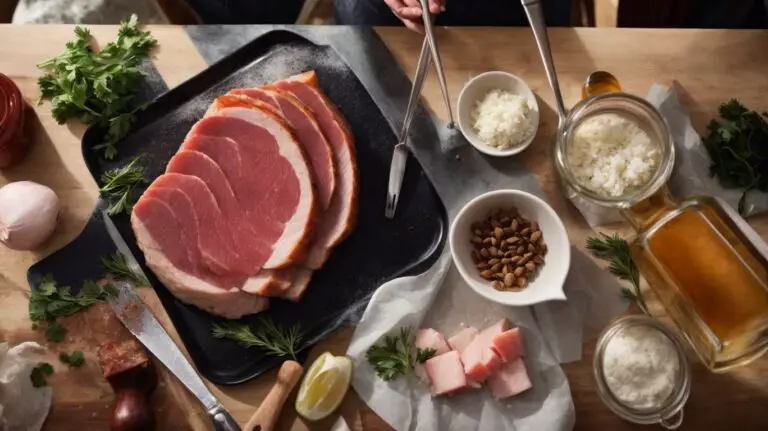How to Cook Steak?
Are you a steak lover looking to perfect your cooking skills?
In this article, we will explore the best cuts of steak, how to choose the right one, preparing the steak, various cooking methods, tips for perfectly cooked steak, and serving and pairing suggestions.
Whether you prefer a juicy Ribeye or a tender Filet Mignon, we’ve got you covered with expert advice from award-winning culinary blogger Chris Poormet.
Get ready to elevate your steak game!
Key Takeaways:
What is the Best Cut of Steak?
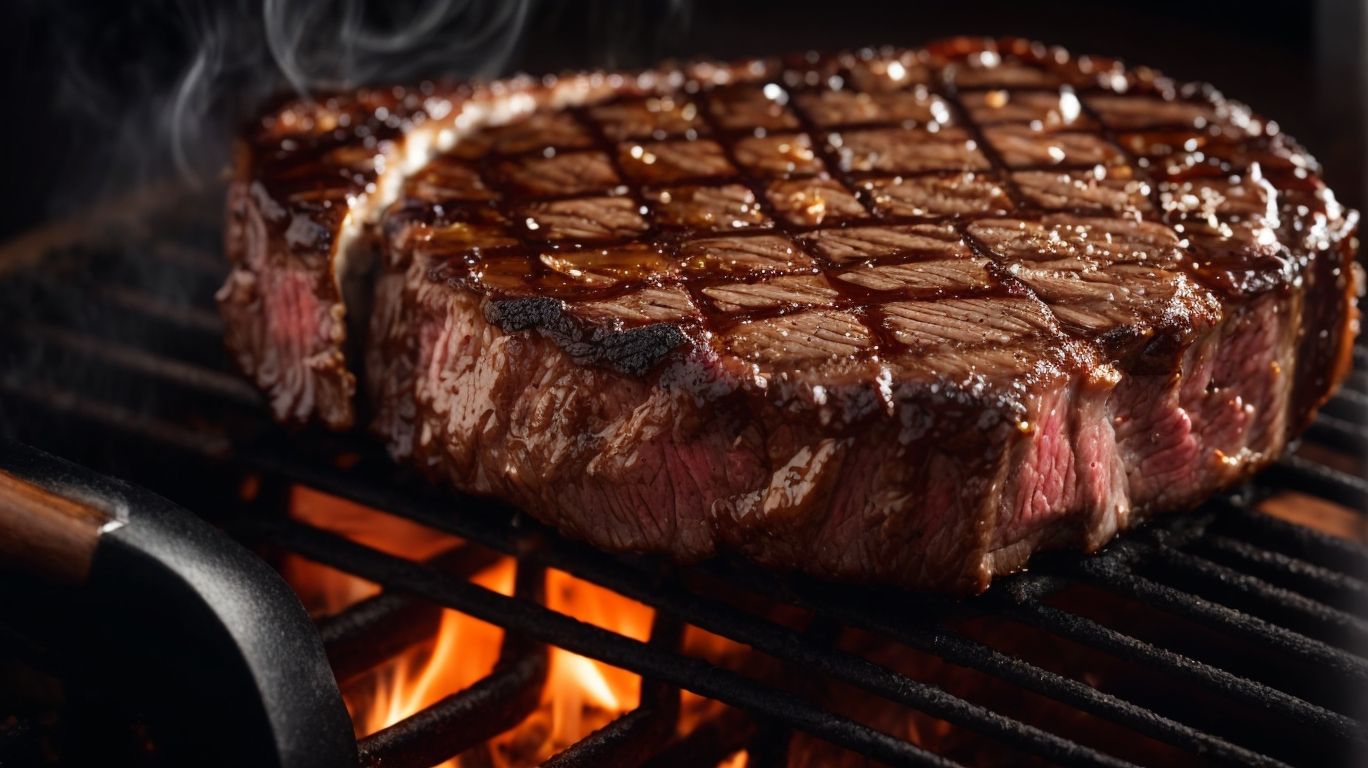
Credits: Poormet.Com – Dylan Thomas
In terms of steak, choosing the best cut is crucial for a delicious meal.
Each steak cut offers a distinct combination of tenderness, juiciness, and flavor. The Ribeye, known for its rich marbling, delivers a buttery texture and intense beefy taste. On the other hand, the Filet Mignon is prized for its tender, melt-in-your-mouth quality with a milder flavor profile. For those seeking a balance between tenderness and robust flavor, the NY Strip is an excellent choice. The T-Bone and Porterhouse cuts, which feature both the tenderloin and strip steak sections, provide a two-in-one experience satisfying different preferences. Cooking a Ribeye benefits from quick searing, while a Filet Mignon requires gentle cooking to maintain its delicate texture.
Ribeye
Ribeye steak is known for its rich marbling and intense flavor profile, making it a favorite among steak enthusiasts.
This marbling, which consists of fine threads of intramuscular fat running through the meat, contributes to its exceptional tenderness and juiciness. When cooked properly, these fat streaks melt into the steak, enhancing its flavor and creating a luxurious mouthfeel.
To ensure you get the best out of your ribeye, opt for USDA Prime grade for the highest quality and superior marbling. When preparing a ribeye steak, a simple seasoning of salt, pepper, and a touch of garlic can complement its natural flavors without overpowering them.
For cooking, searing the ribeye in a hot cast-iron skillet or grilling it over high heat can help caramelize the exterior while keeping the inside tender and juicy. Let the meat rest after cooking to allow the juices to redistribute, ensuring a perfectly succulent bite.
Filet Mignon
Filet Mignon, often called the king of steaks, is prized for its tenderness and mild flavor.
Its luxurious texture comes from being cut from the tenderloin, a less-worked muscle, ensuring a melt-in-your-mouth experience. To maintain its tenderness, it’s crucial not to overcook this delicate cut; a quick sear on high heat is ideal. Many top chefs recommend cooking filet mignon to medium-rare to preserve its softness.
This exquisite steak is a staple in upscale restaurants, where it’s often featured as the star of the menu. Its popularity in fine dining establishments is a testament to its unmatched quality and flavor.
New York Strip
New York Strip steak offers a balance of tenderness and robust beefy flavor, making it a versatile choice for various cooking methods.
Renowned for its fine texture and rich marbling, the NY Strip steak boasts a succulent juiciness that intensifies upon cooking, elevating its taste profile.
- When seared to a perfect medium-rare, this cut delivers a melt-in-your-mouth experience with a pink center, revealing layers of umami goodness.
- For those who prefer a bolder flavor, grilling the steak to medium or medium-well provides a charred exterior that accentuates the beefiness.
Its popularity in steakhouse menus is a testament to its widespread appeal among meat enthusiasts who appreciate the perfect balance of flavor and tenderness.
T-Bone
The T-Bone steak combines the tenderness of filet mignon with the rich flavor of the New York Strip, offering a delightful dining experience.
What makes the T-Bone steak truly unique is its distinctive T-shaped bone running through the center, separating the two cuts of meat. This structure gives you the best of both worlds – the buttery smoothness of the filet on one side and the robust, beefy goodness of the strip on the other. When cooked to perfection, the filet side remains tender and melt-in-your-mouth, while the strip side offers a more intense savory flavor and slightly firmer texture.
To ensure a mouthwatering T-Bone steak, it’s crucial to use a combination of dry heat methods like grilling or broiling to fully accentuate its dual textures and flavors. The high heat from these methods helps to develop a flavorful crust on the outside while maintaining the juiciness within. Remember to season generously and let the steak rest before slicing into it for the perfect dining experience.
Porterhouse
Porterhouse steak is a generous cut that includes both the tenderloin of filet mignon and the flavorful strip steak, providing a decadent eating experience.
This prized steak is known for its ample size, making it an excellent choice for hearty appetites and special occasions. To fully enjoy the Porterhouse’s tenderness and juiciness, it’s crucial to cook it properly. Whether you prefer grilling, broiling, or pan-searing, ensure that the steak is cooked to a perfect medium-rare or medium to avoid toughness and preserve its rich flavors.
The combination of both the tenderloin and strip steak on a Porterhouse makes it a favorite at top-notch steakhouses. Its versatility in accommodating different preferences, from rare to well-done, makes it a popular choice for those seeking a restaurant-quality experience in the comfort of their own home.
How to Choose the Right Steak
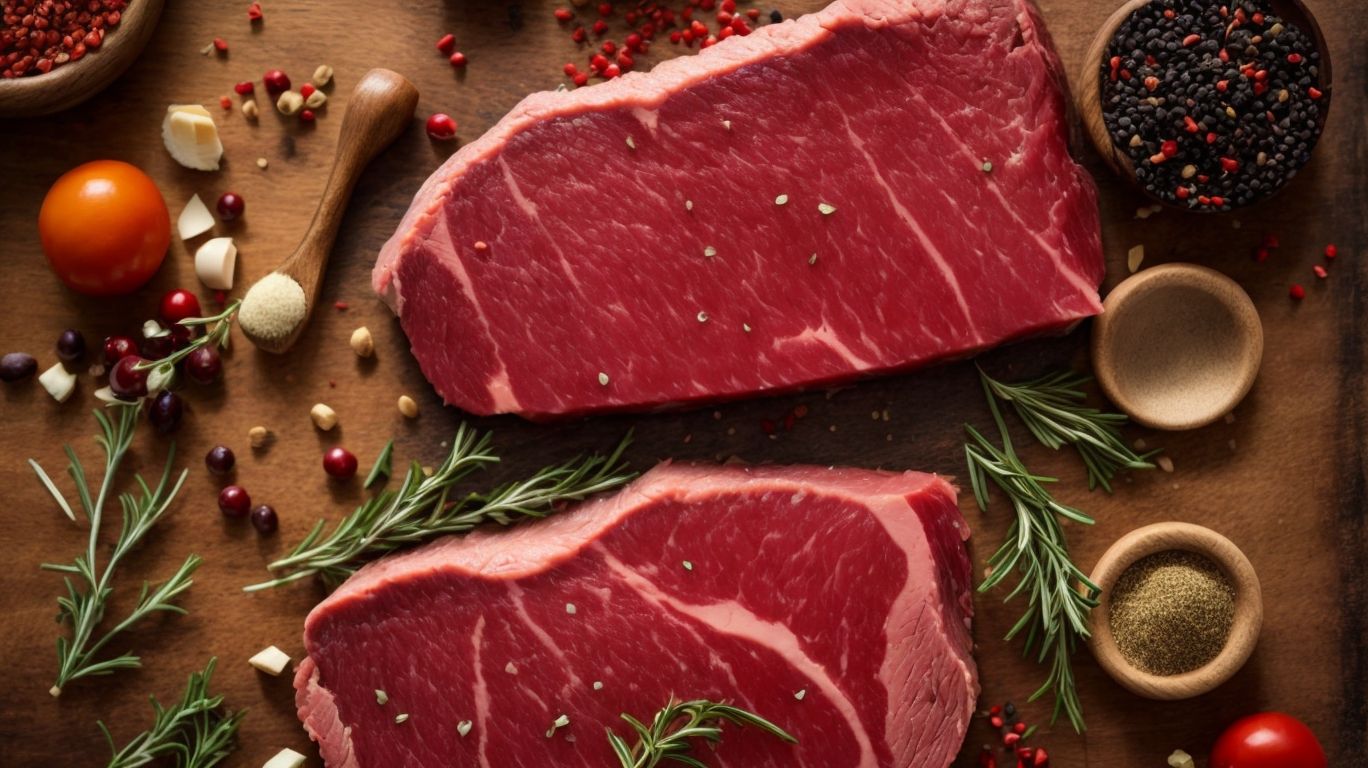
Credits: Poormet.Com – Andrew Sanchez
Selecting the perfect steak involves considering factors such as the quality of meat, marbling, thickness, and aging process.
In terms of meat quality, opting for prime or choice grades ensures a more flavorful and tender steak. Marbling plays a crucial role as it adds moisture and flavor to the meat, enhancing the overall taste profile. The thickness of the steak influences cooking time and control, with thicker cuts allowing for a more precise cooking process. Aging, whether dry or wet, contributes significantly to the tenderness of the steak by breaking down connective tissues and intensifying flavor. All these elements together create a well-rounded and satisfying steak experience.
Quality of Meat
The quality of meat is a key determinant of the steak’s taste, tenderness, and overall dining experience.
Choosing high-quality meat for your steak can significantly elevate the dish, as top-notch meat not only offers superior flavor but also ensures a tender and juicy texture that is highly desirable among steak enthusiasts. When meat is sourced from well-raised animals and is properly aged, it enhances the natural flavors, resulting in a more robust and savory taste profile.
Using premium cuts of meat can lead to greater customer satisfaction as they are more likely to enjoy the dining experience and return for future meals. Investing in high-quality meat ultimately reflects in the final dish, making it a memorable and delightful culinary treat.
Marbling
Marbling, the intramuscular fat in steak, contributes to its juiciness, tenderness, and flavor intensity.
This marbled fat is crucial in creating a melt-in-your-mouth texture and enhancing the overall taste profile of the meat. Different cuts of steak have varying degrees of marbling, with ribeye and New York strip often being known for their generous marbling compared to leaner cuts like filet mignon. When selecting a marbled steak, look for even distribution of fat throughout the meat to ensure consistent flavor and tenderness. Opt for cuts with fine white streaks of fat interspersed within the muscle fibers, as this indicates a well-marbled piece.
Thickness
The thickness of a steak impacts its cooking time, texture, and the ability to achieve the desired level of doneness.
When selecting a steak, consider that thicker cuts heat up more slowly and require longer cooking times compared to thinner cuts. For thinner steaks, around 1/2 to 3/4 inch, a quick sear on high heat is sufficient to cook them to perfection while maintaining a juicy interior. For thicker steaks, around 1 to 1 1/2 inches, a two-zone cooking method is recommended, where you sear the steak over direct heat and then finish cooking over indirect heat to reach the ideal internal temperature without burning the exterior.
Aging
Aging steak enhances its flavor and tenderness by allowing natural enzymes to break down muscle fibers and connective tissue.
One of the key benefits of aging steak is the development of richer, more concentrated flavors that simply cannot be achieved with fresh meat. Through the aging process, the natural enzymes work to tenderize the meat, resulting in a buttery texture that melts in your mouth.
There are two primary methods of aging steak, dry aging and wet aging. Dry aging involves hanging the meat in a controlled environment to allow for a slow and controlled breakdown of enzymes, while wet aging requires vacuum-sealing the meat to enhance tenderness without the flavor concentration of dry aging.
The optimal aging period varies depending on the cut of steak. For example, ribeye steaks typically benefit from around 30 days of aging, while tenderloin steaks may only need 14 days. It’s important to experiment and find the ideal aging time for each cut to maximize flavor and tenderness.
Preparing the Steak
Before cooking the steak, proper preparation is essential to ensure a delectable dining experience.
One of the key steps in preparing a steak is seasoning it generously on both sides with a mixture of salt, pepper, and any desired herbs or spices. This not only enhances the flavor of the meat but also helps create a delicious crust when searing. Allowing the steak to come to room temperature before cooking ensures even cooking throughout, preventing a cold center. It’s also crucial to preheat your cooking surface, whether it’s a grill, skillet, or oven, to achieve that perfect sear and seal in the juices for a juicy steak.
Seasoning
Seasoning the steak with the right blend of spices, herbs, and salt enhances its natural flavors and creates a delicious crust when cooked.
When crafting the perfect seasoning mix for your steak, consider combining classic flavors like garlic, rosemary, and black pepper for a robust taste profile.
Experimenting with smoky paprika, cumin, and chipotle can add a unique twist to your steak.
Remember, the way you season your steak can significantly influence its overall taste and texture, elevating it from ordinary to extraordinary.
Don’t overlook the impact of seasoning on the final dish and be creative in finding the perfect balance of flavors to suit your palate.
Bringing to Room Temperature
Allowing the steak to come to room temperature before cooking ensures even cooking and prevents the meat from seizing up when exposed to heat.
Bringing the steak to room temperature helps to promote a more uniform cooking process. This step allows the steak to cook more evenly from edge to edge, minimizing the risk of overcooking the exterior while the interior remains undercooked. A room temperature steak will sear more effectively, creating a delightful crust on the outside while maintaining a juicy and tender center. To achieve the best results, place the steak on a plate and leave it uncovered at room temperature for about 30-60 minutes before cooking. This simple yet crucial step can elevate the quality of your steak dishes significantly.
Preheating the Pan or Grill
Preheating the cooking surface, whether a pan or grill, is essential to achieve a perfect sear and lock in the steak’s juices during cooking.
When the cooking surface is properly preheated, it creates a Maillard reaction, producing that coveted brown crust on the steak. This reaction, which occurs at temperatures around 400-450°F, adds a depth of flavor and enhances the overall taste of the meat.
A well-preheated surface ensures that the steak cooks evenly, preventing it from becoming overcooked on the outside while still being rare in the middle. This precision in temperature control guarantees that the steak’s texture remains tender and juicy, enticing your taste buds with every bite.
Cooking Methods
Various cooking methods can be employed to achieve the desired doneness and flavor profile for a perfectly cooked steak.
One popular technique is pan-searing, where the steak is cooked in a hot pan with oil or butter to develop a caramelized crust while locking in the juices.
Grilling, on the other hand, imparts a smoky flavor from the open flame, adding an extra dimension to the meat.
Broiling involves cooking the steak under high direct heat in the oven, producing a delicious charred exterior.
For a more precise and controlled method, sous vide cooking entails vacuum-sealing the steak and cooking it in a water bath at a consistent low temperature, resulting in evenly cooked meat with a tender texture.
Pan-Seared
Pan-searing steak involves cooking it over high heat with butter and thyme to create a flavorful crust while achieving a perfect medium-rare doneness.
When pan-searing steak, it’s crucial to have a hot pan to ensure proper searing. Begin by seasoning the steak generously with salt and pepper to enhance its flavors. Wait until the pan is smoking hot before adding the butter to achieve that beautiful caramelization. As the steak cooks, resist the temptation to constantly flip it; allow each side to sear undisturbed to develop a nice crust. To achieve a delectable medium-rare finish, use a meat thermometer to ensure an internal temperature of around 130°F (54°C).
Grilled
Grilling steak over high heat imparts a smoky flavor, beautiful grill marks, and a delicious charred exterior.
When grilling steak, it’s crucial to season it properly to elevate its flavor. Consider using a simple yet flavorful blend of salt, pepper, garlic powder, and paprika to enhance the natural taste of the beef.
High heat not only sears the steak quickly to lock in juices but also creates those coveted grill marks that add a visually appealing touch to your dish. These grill marks not only look impressive but also provide a hint of caramelized flavor.
Broiled
Broiling steak in the oven results in a beautifully seared surface and a juicy interior, creating a delightful contrast in texture and flavor.
When broiling steak, achieving that perfect sear on the outside is crucial. Preheat your broiler so the steak immediately starts cooking upon entering the oven. To enhance the browning, pat the steak dry with paper towels before seasoning it. For a tender texture, consider marinating the steak beforehand to infuse it with flavor and tenderness. Ensure the steak is at room temperature before broiling to promote even cooking. Remember to use a broiler pan or a wire rack set in a baking sheet to allow excess fat to drip away during cooking, preventing steaming and ensuring that delicious charring effect. Keep a close eye on the steak as broiling times vary depending on the thickness of the cut. Let the steak rest for a few minutes after cooking to allow the juices to redistribute for optimal juiciness. By following these tips, you can elevate your steak broiling game and create a restaurant-quality dish at home.
Sous Vide
Sous vide cooking ensures precise temperature control, resulting in a perfectly cooked steak with consistent doneness throughout.
This cooking method involves sealing the steak in a vacuum-sealed bag and immersing it in a water bath kept at a specific temperature typically lower than traditional cooking methods. This gentle, controlled cooking environment helps retain the natural juices and flavors of the meat while ensuring the desired level of doneness, whether rare, medium-rare, or well-done.
Sous vide machines are used to regulate the water temperature precisely, eliminating the risk of overcooking or undercooking the steak. The prolonged cooking times associated with this technique also allow for tough cuts of meat to become tender and flavorful.
Tips for Perfectly Cooked Steak
Achieving the perfect steak requires attention to detail and adherence to essential cooking tips.
One key tip to ensure your steak is cooked to perfection is to use a meat thermometer to gauge the internal temperature accurately. This prevents overcooking or undercooking, resulting in a juicier and more flavorful steak. Allowing the steak to rest for a few minutes after cooking is crucial to retain its juices and tenderness. When it’s time to slice the steak, remember the importance of cutting against the grain for optimal tenderness, as this method breaks down the muscle fibers and makes the steak more enjoyable to eat.
Use a Meat Thermometer
Utilizing a meat thermometer enables you to cook your steak precisely to your desired level of doneness, whether rare, medium-rare, or well-done.
By accurately measuring the internal temperature of the steak, you ensure that it reaches the perfect level of doneness without any guesswork. This not only results in a more consistent and enjoyable eating experience but also minimizes the risk of undercooking or overcooking the meat.
Using a meat thermometer allows you to avoid the common mistake of cutting into the steak to check for doneness, which can cause the flavorful juices to escape, leading to a dry and less tasty piece of meat. Resting the steak after cooking is crucial as it allows the juices to redistribute, resulting in a juicier and more tender steak.
Resting the Steak
Allowing the steak to rest after cooking ensures optimal juiciness as the meat relaxes, juices redistribute, and flavors intensify.
One effective technique for resting steak is tenting it with aluminum foil. This helps to trap the heat and allows the juices to redistribute evenly throughout the meat, resulting in a more tender and flavorful steak.
During the resting period, you may hear a satisfying sizzling sound as the heat gently continues to cook the steak. To ensure an even finish, the best time to flip the steak during resting is when half of the recommended resting time has passed, allowing both sides to absorb the juices and flavors equally.
Cutting Against the Grain
Slicing steak against the grain breaks up muscle fibers, resulting in a more tender and enjoyable eating experience.
When you cut meat, you’ll notice long lines running through the muscle. The grain refers to the direction of these lines. By slicing against the grain, you are essentially cutting perpendicular to these lines, shortening the muscle fibers. This method reduces the chewiness of the meat and makes it easier to bite and chew.
For visual aid, examine the steak closely before cutting. The muscle fibers will be evident as parallel lines. Once you’ve identified the direction of the grain, position your knife perpendicular to it for optimal slicing. Cutting against the grain is a simple yet effective way to enhance the tenderness of your steak.
Serving and Pairing Suggestions
Enhance the dining experience by serving your perfectly cooked steak with complementary side dishes, delectable steak sauces, and well-paired wines.
In terms of steak sauces, it’s essential to choose something that complements the flavor of the meat without overpowering it. For a classic pairing, consider a rich and creamy peppercorn sauce with a juicy filet mignon, or a tangy chimichurri sauce to enhance the taste of a grilled ribeye.
For side dishes, opt for options that add texture and balance to your meal. Roasted vegetables like asparagus or brussels sprouts can bring a delightful crunch, while a creamy loaded baked potato or a refreshing caprese salad can provide a contrast in flavors.
When selecting wines, remember that a well-paired glass can elevate the entire dining experience. A bold Malbec or a classic Cabernet Sauvignon pairs beautifully with a rich steak, while a crisp Sauvignon Blanc complements lighter cuts like flank steak.
Steak Sauces
Pairing your steak with the right sauce can enhance its flavors, add complexity, and provide a delightful contrast in textures.
In terms of popular steak sauces, Béarnaise sauce stands out as a classic choice, rich in buttery goodness with a tangy touch of tarragon. This velvety sauce pairs impeccably with a tender filet mignon or a juicy ribeye, elevating the indulgent experience.
On the other hand, Chimichurri sauce brings a burst of freshness with its mix of parsley, garlic, and vinegar; ideal for complementing the bold flavors of a skirt steak or flank steak.
The zesty kick of Peppercorn sauce is a great accompaniment to a peppery New York strip, enhancing the robust taste with its creamy texture.
Side Dishes
Serving your steak with delicious side dishes like roasted potatoes, buttery carrots, or a crisp wedge salad can elevate the meal to a memorable dining experience.
Roasted potatoes perfectly complement the rich flavors of steak with their crispy exterior and fluffy interior. For a twist, try seasoning them with garlic, rosemary, and parmesan for an extra burst of flavor.
Buttery carrots add a touch of sweetness to balance the savory steak. You can glaze them with honey and balsamic vinegar or simply roast them with a sprinkle of thyme and orange zest for a burst of freshness.
A crisp wedge salad brings a refreshing crunch to the meal. Top it with creamy blue cheese dressing, crispy bacon, and cherry tomatoes for a burst of contrasting flavors.
Wine Pairings
Pairing your steak with the right wine can enhance the dining experience, with red wine sauces or robust reds complementing the steak’s flavors.
When choosing a wine to pair with a rich cut like ribeye, a bold red such as Cabernet Sauvignon or Malbec can stand up to the meat’s intensity. For a leaner steak like filet mignon, a Pinot Noir or Merlot with softer tannins can provide a more delicate balance. Lamb chops pair wonderfully with a Syrah or a Zinfandel that can amplify the savory notes in the meat. The intricate dance between the flavors of your steak and the wine you choose can elevate your meal to a gourmet experience.
Frequently Asked Questions
1. What is the best way to cook steak?
The best way to cook steak is by using a high-heat cooking method such as grilling or pan-searing.
2. How do I know when my steak is cooked to perfection?
The best way to determine the doneness of your steak is by using a meat thermometer. For medium-rare, the internal temperature should be 135°F.
3. Can I cook steak in the oven?
Yes, you can cook steak in the oven by broiling it for a few minutes on each side or by using a low and slow cooking method, like braising.
4. How can I make my steak more tender?
To make your steak more tender, you can marinate it for a few hours before cooking or use a meat tenderizer tool to tenderize the meat.
5. How long should I let my steak rest before slicing?
It is recommended to let your steak rest for at least 5-10 minutes before slicing to allow the juices to redistribute and keep the meat juicy.
6. How do I know which cut of steak to choose?
The best cuts of steak for cooking are ribeye, sirloin, and filet mignon. It is also important to consider the marbling and thickness of the steak when choosing the cut.

